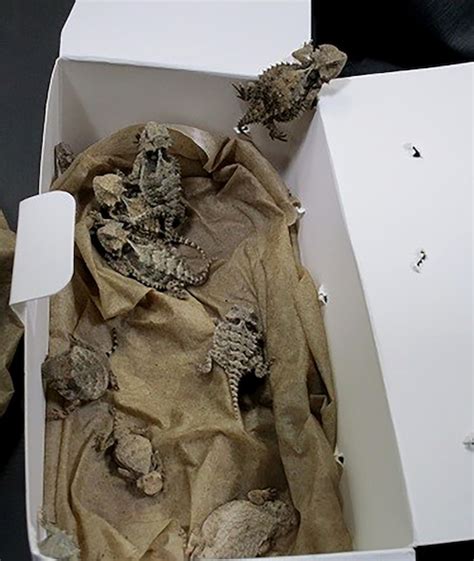
A U.S. Customs and Border Protection (CBP) officer at the San Ysidro Port of Entry thwarted an attempt to smuggle 52 reptiles, including horned lizards and baby turtles, concealed inside a traveler’s clothing. The incident, which occurred on February 25th, highlighted the ongoing efforts to combat wildlife trafficking and the vigilance of border security personnel.
SAN YSIDRO, CA – A vigilant Customs and Border Protection (CBP) officer at the San Ysidro Port of Entry made a startling discovery on February 25th, uncovering an attempt to smuggle 52 live reptiles into the United States. The reptiles, a mix of horned lizards and juvenile turtles, were concealed on the person of an individual attempting to cross the border from Mexico. The interception underscores the persistent threat of wildlife smuggling and the critical role of CBP officers in safeguarding biodiversity and enforcing wildlife protection laws.
According to a CBP statement released on Monday, the incident unfolded when the officer noticed “unusual protrusions” on the individual’s clothing during a routine inspection. Upon further investigation, the officer discovered the reptiles, which were carefully wrapped and hidden on the person’s body. The species included several types of horned lizards, native to North America, and various species of baby turtles.
“CBP officers are highly trained in identifying anomalies,” said Sidney Aki, CBP Director of Field Operations in San Diego. “Their attention to detail led to this discovery and prevented these animals from potentially harming our ecosystem.”
The attempted smuggling operation represents a significant violation of both U.S. and international wildlife protection laws. Smuggling live animals poses a threat not only to the animals themselves, which are often subjected to inhumane conditions during transport, but also to the ecosystems into which they might be introduced. Invasive species can disrupt local food chains, spread diseases, and cause significant economic damage.
The seized reptiles were immediately turned over to U.S. Fish and Wildlife Services (USFWS) for proper identification, veterinary inspection, and care. USFWS will also conduct further investigations to determine the origin of the reptiles and the intended destination. Depending on the species and the circumstances of the smuggling attempt, the individual involved could face substantial fines, imprisonment, and other penalties.
This incident is not an isolated case. Wildlife smuggling is a global problem, with traffickers exploiting vulnerable species for profit. The United States is a major market for illegally traded wildlife, and CBP officers play a vital role in intercepting shipments of protected animals and plants at ports of entry across the country.
The San Ysidro Port of Entry is one of the busiest land border crossings in the world, processing thousands of vehicles and pedestrians daily. The high volume of traffic presents a challenge for CBP officers, who must remain vigilant in detecting illegal activity while ensuring the efficient flow of legitimate trade and travel.
The successful interception of the reptile smuggling attempt at San Ysidro highlights the ongoing commitment of CBP to protecting wildlife and enforcing environmental laws. It also serves as a reminder of the importance of international cooperation in combating wildlife trafficking. By working together, countries can disrupt criminal networks, protect endangered species, and preserve the biodiversity of our planet.
The incident is under further investigation by both CBP and USFWS. Details about the individual involved, including their identity and nationality, have not been released. The focus remains on ensuring the well-being of the seized reptiles and preventing future smuggling attempts.
The Broader Context of Wildlife Smuggling
Wildlife smuggling is a multi-billion dollar industry that threatens biodiversity and fuels organized crime. The demand for exotic pets, traditional medicines, and luxury goods drives the illegal trade in wildlife, with devastating consequences for vulnerable species.
The Convention on International Trade in Endangered Species of Wild Fauna and Flora (CITES) is an international agreement that regulates the trade in endangered and threatened species. The United States is a signatory to CITES and has enacted domestic laws to implement its provisions. These laws prohibit the import, export, and interstate sale of wildlife that has been taken in violation of foreign laws or treaties.
However, despite these efforts, wildlife smuggling remains a persistent problem. Traffickers are constantly developing new methods to evade detection, and the profits from illegal wildlife trade are often used to finance other criminal activities.
The Role of U.S. Customs and Border Protection
CBP officers are on the front lines of the fight against wildlife smuggling. They are trained to identify protected species, detect smuggling attempts, and enforce wildlife protection laws. CBP works closely with USFWS and other agencies to coordinate enforcement efforts and share intelligence.
CBP also uses advanced technology to detect smuggling attempts. X-ray machines, canine teams, and other tools help officers to identify hidden compartments and concealed contraband.
In addition to intercepting illegal wildlife shipments, CBP also works to educate the public about the dangers of wildlife smuggling. By raising awareness of the issue, CBP hopes to reduce the demand for illegally traded wildlife and help protect endangered species.
The Impact on Ecosystems
The introduction of non-native species into an ecosystem can have devastating consequences. Invasive species can outcompete native species for resources, spread diseases, and disrupt food chains.
For example, the Burmese python, a non-native snake that has become established in Florida, has decimated populations of native mammals. The pythons prey on deer, raccoons, opossums, and other animals, threatening the ecological balance of the Everglades.
The smuggling of reptiles and other wildlife can also introduce diseases that can harm native populations. Chytridiomycosis, a fungal disease that affects amphibians, has caused widespread declines in frog and salamander populations around the world. The disease is believed to have been spread by the international trade in amphibians.
The Importance of International Cooperation
Wildlife smuggling is a global problem that requires international cooperation to solve. Countries must work together to strengthen laws, share intelligence, and coordinate enforcement efforts.
CITES provides a framework for international cooperation on wildlife protection. The agreement establishes a system of permits and certificates to regulate the trade in endangered and threatened species. CITES also promotes cooperation among countries to combat wildlife smuggling and enforce wildlife protection laws.
In addition to CITES, there are a number of other international agreements that address wildlife protection. The Convention on Biological Diversity, for example, promotes the conservation of biodiversity and the sustainable use of natural resources.
The Legal Ramifications of Wildlife Smuggling
Wildlife smuggling carries significant legal penalties in the United States. Violators can face fines, imprisonment, and the forfeiture of property.
The Lacey Act is a U.S. law that prohibits the import, export, sale, and possession of wildlife that has been taken in violation of foreign laws or treaties. The law also prohibits the import, export, sale, and possession of plants that have been taken in violation of state or federal laws.
The Endangered Species Act is a U.S. law that protects endangered and threatened species of plants and animals. The law prohibits the taking, import, export, and sale of endangered and threatened species.
Individuals convicted of wildlife smuggling can face substantial fines and imprisonment. In addition, they may be required to forfeit any property that was used in the commission of the crime.
The Future of Wildlife Protection
Wildlife smuggling is a complex and challenging problem that requires a multi-faceted approach to solve. Strengthening laws, increasing enforcement, reducing demand, and promoting international cooperation are all essential to protecting wildlife from illegal trade.
Technological advancements are also playing an increasingly important role in the fight against wildlife smuggling. DNA analysis, for example, can be used to identify the origin of illegally traded wildlife. Satellite tracking can be used to monitor the movement of endangered species and detect illegal poaching activity.
By working together, governments, organizations, and individuals can make a difference in the fight against wildlife smuggling and protect the biodiversity of our planet. The vigilance of CBP officers like the one at the San Ysidro Port of Entry remains a critical component of this effort.
Details of the Smuggled Reptiles
The smuggled reptiles consisted of both horned lizards and juvenile turtles. Horned lizards, also known as horny toads, are a genus of lizards native to North America. They are characterized by their flattened bodies, spiky scales, and the horns on their heads. Horned lizards are adapted to arid environments and feed primarily on ants. Several species of horned lizards are considered to be threatened or endangered due to habitat loss and other factors.
The juvenile turtles included various species, the exact species of which have yet to be released by USFWS. Baby turtles are particularly vulnerable during transport, as they require specific environmental conditions to survive. Smuggling these animals often results in high mortality rates.
The value of the smuggled reptiles is difficult to determine, as it depends on the species, their rarity, and the intended market. However, exotic reptiles can fetch high prices in the pet trade, making them attractive targets for smugglers.
The San Ysidro Port of Entry: A Hotspot for Smuggling
The San Ysidro Port of Entry is the busiest land border crossing in the Western Hemisphere, handling a massive volume of vehicle and pedestrian traffic every day. This high traffic volume makes it an attractive target for smugglers attempting to bring illegal goods into the United States.
CBP officers at San Ysidro are constantly on the lookout for drugs, weapons, and other contraband. They use a variety of techniques to detect smuggling attempts, including visual inspection, X-ray technology, and canine teams.
The port has been the site of numerous high-profile smuggling busts in recent years, including seizures of narcotics, weapons, and counterfeit goods. The successful interception of the reptile smuggling attempt highlights the ongoing challenges faced by CBP officers at San Ysidro and their commitment to protecting the border.
The U.S. Fish and Wildlife Service’s Role
The U.S. Fish and Wildlife Service (USFWS) is the federal agency responsible for protecting and managing fish, wildlife, and their habitats. USFWS works to conserve endangered and threatened species, enforce wildlife protection laws, and promote responsible stewardship of natural resources.
In the case of the reptile smuggling attempt at San Ysidro, USFWS is responsible for taking custody of the seized reptiles, providing them with veterinary care, and determining their origin and intended destination. USFWS will also conduct further investigations to identify the individuals involved in the smuggling operation and bring them to justice.
USFWS plays a crucial role in combating wildlife smuggling by working with CBP and other agencies to intercept illegal shipments of protected animals and plants. The agency also works to educate the public about the dangers of wildlife smuggling and promote responsible wildlife viewing and conservation practices.
The Importance of Public Awareness
Public awareness is essential to combating wildlife smuggling. By educating the public about the dangers of the illegal wildlife trade, we can reduce the demand for illegally traded wildlife and help protect endangered species.
There are a number of ways to raise awareness about wildlife smuggling. Schools, museums, and other organizations can offer educational programs about wildlife conservation. The media can play a role by reporting on wildlife smuggling cases and highlighting the impact of the illegal trade on ecosystems and endangered species.
Individuals can also make a difference by making informed consumer choices and supporting organizations that are working to protect wildlife. By choosing to buy products that are sustainably sourced and avoiding products made from endangered species, we can help reduce the demand for illegally traded wildlife.
The Future of Border Security and Wildlife Protection
The incident at the San Ysidro Port of Entry underscores the evolving challenges of border security and the increasing sophistication of smuggling operations. As technology advances and global trade expands, CBP and USFWS must continue to adapt their strategies to effectively combat wildlife smuggling and protect our nation’s borders.
Investing in advanced technology, enhancing training for border security personnel, and strengthening international cooperation are all critical steps in the ongoing effort to prevent wildlife smuggling and safeguard biodiversity. The vigilance and dedication of CBP officers, like the one who uncovered the reptile smuggling attempt, remain essential to this mission. The continued collaboration between CBP, USFWS, and other agencies will be paramount in addressing the complex challenges of wildlife protection in the years to come.
The incident also emphasizes the need for continued public education and awareness. By informing the public about the devastating impacts of wildlife smuggling and promoting responsible consumer choices, we can collectively contribute to reducing the demand for illegally traded wildlife and protecting endangered species for future generations. The combined efforts of law enforcement, conservation organizations, and the public are crucial in ensuring the long-term survival of vulnerable wildlife populations and preserving the integrity of our ecosystems.
FAQ Section:
Q1: What types of reptiles were being smuggled, and why is this significant?
A1: The smuggled reptiles included horned lizards and juvenile turtles. The specific species of turtles were not immediately identified. This is significant because these animals are often taken from their natural habitats, potentially disrupting ecosystems. Horned lizards, in particular, are native to North America, and some species are considered threatened or endangered. Smuggling them violates both U.S. and international wildlife protection laws and can harm vulnerable populations. Also, the smuggling of baby turtles is especially cruel since they need specific conditions to survive, and they often die during transport.
Q2: How did the CBP officer discover the smuggled reptiles?
A2: The CBP officer noticed “unusual protrusions” on the individual’s clothing during a routine inspection. This keen observation, coupled with the officer’s training in identifying anomalies, led to the discovery of the reptiles concealed on the person’s body. Sidney Aki, CBP Director of Field Operations in San Diego, emphasized the importance of the officers’ training, stating, “CBP officers are highly trained in identifying anomalies. Their attention to detail led to this discovery and prevented these animals from potentially harming our ecosystem.”
Q3: What happens to the smuggled reptiles after they are seized by CBP?
A3: The seized reptiles were immediately turned over to the U.S. Fish and Wildlife Service (USFWS) for proper identification, veterinary inspection, and care. USFWS will assess the health of the animals, determine their species and origin, and make arrangements for their long-term care, which may include placement in a zoo, sanctuary, or, if appropriate, eventual release back into the wild.
Q4: What are the potential penalties for wildlife smuggling in the United States?
A4: The penalties for wildlife smuggling in the United States can be severe, depending on the species involved, the scale of the operation, and the specific laws violated. Penalties can include substantial fines, imprisonment, and the forfeiture of property used in the commission of the crime. The Lacey Act and the Endangered Species Act are two key U.S. laws that provide for these penalties. The individual involved in this specific incident could face these penalties, along with other legal repercussions.
Q5: How does wildlife smuggling impact ecosystems and biodiversity?
A5: Wildlife smuggling poses a significant threat to ecosystems and biodiversity. The removal of animals from their natural habitats can disrupt food chains and ecological balance. Invasive species, introduced through smuggling, can outcompete native species, spread diseases, and cause significant economic damage. The inhumane conditions during transport often lead to high mortality rates among smuggled animals, further impacting vulnerable populations. Furthermore, the illegal wildlife trade can drive certain species toward extinction.









